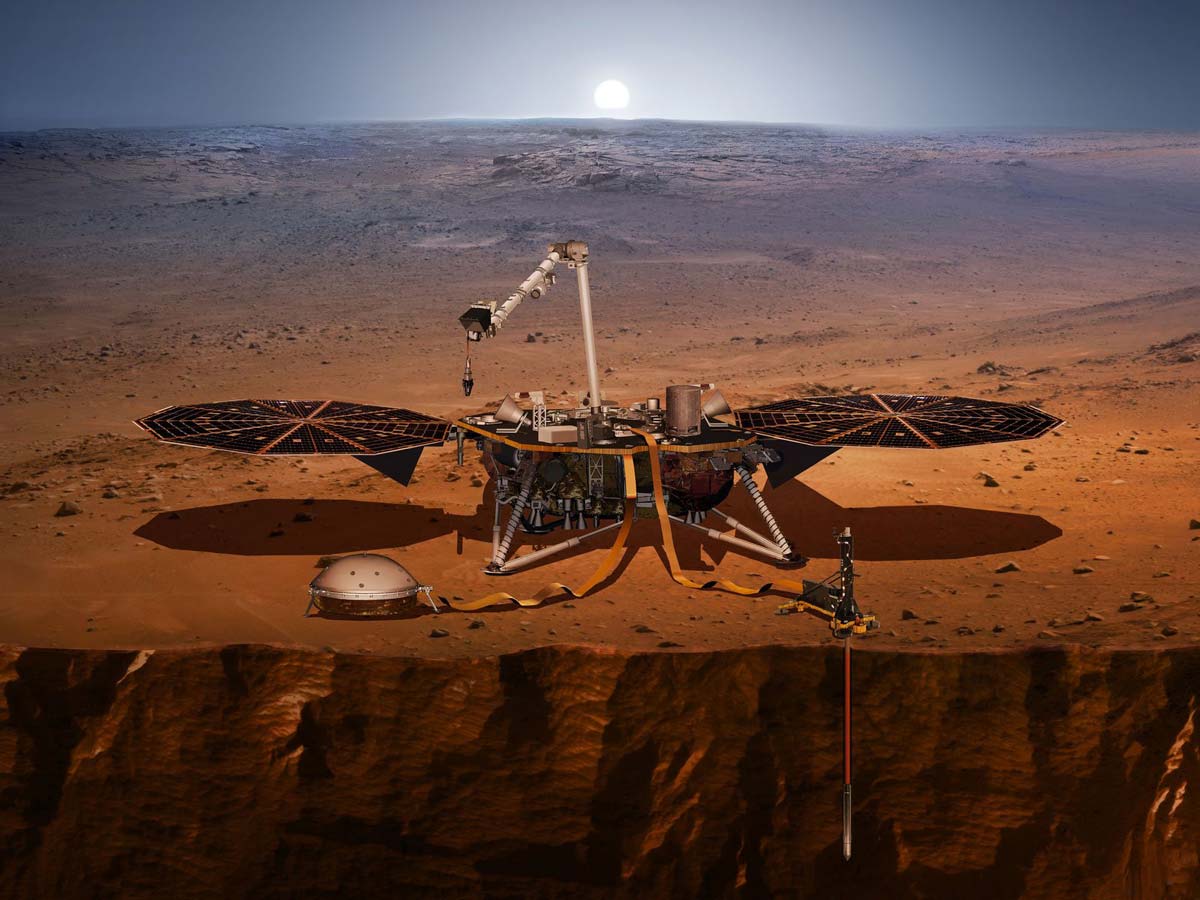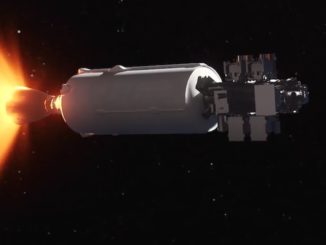
Later this month, ground teams will send commands for the InSight lander on Mars to use its robotic arm in a series of carefully-choreographed movements to help inspect, and potentially assist, one of the mission’s main geologic instruments that stalled as it hammered into the Red Planet’s crust earlier this year.
Officials settled on the plan after lengthy testing using ground models of InSight’s heat flow probe at the NASA’s Jet Propulsion Laboratory in California, where the mission is managed, and at the German Aerospace Center, which developed the instrument.
The German-built Heat Flow and Physical Properties Package, or HP3, instrument began hammering into Martian subsurface Feb. 28, aiming to reach a depth of up to 16 feet (5 meters) — deeper than any previous Mars lander — with a series of thousands of hammer blows planned in several stages over several weeks.
But within minutes, an obstruction stopped the mole at a depth of roughly 1 foot (30 centimeters), diverting the probe to a tilt of roughly 15 degrees. Further attempts to dig deeper have been unsuccessful, and experts believe the Martian soil at InSight’s landing site is not offering enough friction, or resistance, to prevent the mole from recoiling with each hammer stroke.
Martian gravity is about one-third that of Earth, adding another complexity to the hammering operation with the 1.3-foot-long (40-centimeter) mole. Scientists suspect small, slot-shaped cavities may have formed between the mole and the surrounding soil, according to the German Aerospace Center, or DLR.
Mission managers have approved a risky plan to use InSight’s robotic arm for a task it was not designed to do. The arm will gently pick up the HP3 instrument’s support structure, which sits on the Martian surface over the partially-buried mole, to allow ground teams to get a better look at the instrument’s condition.
“We want to lift the support structure because we cannot visualize the mole beneath the subsurface, and we therefore do not know what situation it is in,” said Tilman Spohn, principal investigator for the HP3 experiment at the DLR Institute of Planetary Research. “We are now rather sure that the insufficient grip from the soil around the mole is a problem, because the friction caused by the surrounding regolith under the lower gravitational attraction on Mars is much weaker than we expected.”
Scientists considered whether the mole may have hit a rock underground that stopped its progress, but ground teams now believe the friction explanation is more likely, Spohn said. Officials were also concerned that an umbilical tether trailing behind the mole may have been snagged in the support structure, but that scenario is also unlikely, officials said.

InSight’s robotic arm placed the HP3 instrument on the surface of Mars early this year, following the spacecraft’s landing on Mars on Nov. 26. Along with a seismometer, the HP3 instrument rode to Mars on the InSight lander’s payload deck, but the arm was not intended to pick up the instruments once placed on the surface.
Beginning in late June, the arm will grasp the HP3 instrument’s support structure with a gripper device. Ground teams will divide the robot arm’s movements into three steps, pausing in between to take images so engineers on the ground can make sure the mole is not pulled out of the ground, according to NASA.
Springs inside the support structure may still be in contact with the mole, so lifting the instrument too quickly could threaten to pull the mole out of the ground.
“If that is the case, we want to be careful lifting the structure so that we do not accidentally pull the mole out of the ground,” said Troy Hudson, a NASA engineer, in a statement. “If that happens, we will not be able to insert it back into its hole or move it elsewhere, since the arm has no way of picking up the mole directly. So we will lift the support structure a little bit at a time, checking to make sure the mole is not coming with it.”
If the mole comes out of the ground, it cannot be used again. Even if the arm could pick up the mole directly and place it at another location within the reach of the stationary lander, ground teams expect it would encounter the same friction problem because of similar soil properties.
“The procedure is not without risk,” NASA said in a statement. “However, mission managers have determined that these next steps are necessary to get the instrument working again.”
Once the support structure is out of the way, scientists will assess the best way to assist the mole.
“We plan to use the robotic arm to press on the soil close to the mole,” Spohn said in a statement. “This additional load will increase the pressure on the penetrator and thus the friction on its outer surface.
“Our calculations at DLR suggest that we have to get close to the device,” he said. “Immediately above the mole, which is positioned at a small angle to the vertical with respect to the surface, and close to it, the effect is greatest. Without removing the support structure, we would be too far away, and the effect would be too small.”
The HP3 instrument is designed to gather data on underground temperatures at varying depths, giving scientists a clearer understanding of the amount of heat escaping the Martian interior. HP3 is one of two geophysics instruments InSight carried to Mars, along with a French-built seismometer, which is working as expected and has already detected multiple marsquakes.

The seismometer recorded its first marsquake April 6, and the instrument registered its largest seismic signal to date May 22, a tremor scientists estimate at magnitude 3.0.
A third major science investigation on the InSight mission is the Rotation and Interior Structure Experiment, or RISE, which uses radio signals passed between the lander and Earth to measure the wobble of Mars’s rotation, giving scientists an idea of the Red Planet’s core size and density.
The $1 billion InSight mission launched May 5, 2018, aboard an Altas 5 rocket from Vandenberg Air Force Base in California, and reached the Red Planet nearly seven months later, culminating its interplanetary voyage Nov. 26 with a rocket-assisted landing on a broad flat plain near the Martian equator.
InSight is the first Mars mission dedicated to studying the planet’s deep interior. Data from InSight’s instruments are expected to help scientists understand how rocky planets formed in the early solar system some 4.5 billion years ago.
Email the author.
Follow Stephen Clark on Twitter: @StephenClark1.



